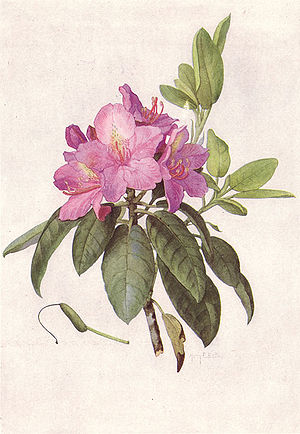National Geographic Magazine/Volume 31/Number 6/Our State Flowers/Rhododendron
Our State Flowers
[edit]The Rhododendron (Rhododendron maximum Michx.)
[edit]
MOUNTAIN AMERICAN RHODODENDRON
Rhododendron maximum Michx.
The superb beauty of the rhododendron has won for it universal admiration and the distinction of being the flower of two States. The legislature of West Virginia and the State organization of women's clubs in Washington have elevated it above all other floral rivals in their communities. The chosen variety of West Virginia is Rhododendron maximum, while that of Washington is Rhododendron californicum, also called the California rose bay. The latter is the most splendid of western shrubs. Both kinds are of the heath family, cousins of the mountain laurel, and have delicate, waxen blossoms tinted like the “rosy-fingered dawn,” with upper petals flecked with golden and greenish spots.
A true artist in selecting its background, the rhododendron not only surrounds its exquisite blossoms with smooth, rich green leaves which set them off effectively, but also makes its home commonly on moist, forested mountainsides, where the gloomy greens and browns of dark rocks and lofty trees contrast with its dainty pink and white ruffles.
The rhododendrons growing in Washington, or among the redwoods of California, or clothing the slopes of the Alleghenies with impenetrable thickets and in early summer glorifying them with bloom, are worth going far to see.
At its best, and rarely, the shrub attains a height of 35 feet. Its form, with spreading branches, twisting and interlocking, calls to mind the Greek meaning of its name, “rose tree.” In less favorable locations the plant is sometimes less than five feet high. The wood is one of the strongest and hardest that grows and weighs 39 pounds to the cubic foot.
The rhododendron has no such clever trick of showering its pollen upon insect visitors as the mountain laurel, but, like the laurel, it protects itself by a sticky substance below the flower from ants and crawling insects which do not transfer pollen. The bee and other insect friends of the rhododendron find its nectar very gratifying, but the honey they make from it is said to be poisonous.
To the deeper pink, rather purplish rhododendron of the Carolinas, European gardeners pay the homage of careful cultivation, as they do also to some varieties native to Asia.
Americans might fittingly revive England's “Maying” custom and set aside an early summer day for pilgrimages to our mountains where the laurel and rhododendron bloom, in order properly to appreciate these perfect gifts of Nature.
Source: —, ed. (June 1917), “Our State Flowers: The Floral Emblems Chosen by the Commonwealths”, The National Geographic Magazine 31(6): 500, 517. (Illustration from page 516.)